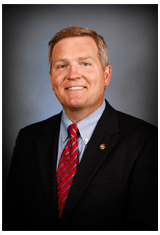It’s hard to believe the legislative session will be here in just a few months and we’ll begin prefiling legislation on Dec. 1. Now is an important time to focus on what we want to accomplish in the upcoming session. Recently, I had the opportunity to meet with members of Complete College America in a legislative panel to discuss what the Missouri General Assembly accomplished during the last session to benefit higher education, as well as future possibilities to continue improving the access and affordability of higher education in Missouri. In addition, I attended the National Conference of State Legislature’s Institution on Higher Education, which focused on connecting higher education to workforce needs and ensuring that our students have the career skills necessary to be successful when they enter the workforce.
I was joined in these conferences by other higher education leaders to discuss how to bolster higher education and increase completion rates in a shorter period in order to get more educated citizens in the workforce faster and with less debt. Undergraduate enrollment has doubled in the United States between 1970 and 2009. However, completion rates have remained virtually unchanged.
In Missouri, the Senate Education Committee and the Joint Committee on Education have both been involved in the process of setting goals and developing plans in order to better assist our more than 219,000 students currently enrolled in public higher education. Thirty-three other states have shared how they are setting completion goals, collecting and reporting common measures of progress, developing action plans and moving key policy levers.
Last session’s Senate Bill 381, creating innovation education campuses, was an important piece of legislation and had a tremendous impact on the University of Central Missouri in the 21st District. By creating an educational partnership among local schools, businesses, and two- and four-year institutions of higher education, SB 381 opens the opportunity to both lower the cost and decrease the amount of time it takes to obtain a degree. The measure also allows the student to work directly with the business he or she will look to for a career, learning job-specific information from their future employers.
Two other important pieces of legislation that were discussed last session, but did not pass, were Senate Bill 437 and Senate Bill 378. Performance-based funding for higher education institutions, such as that encouraged by SB 437 is currently used by 34 other states. Performance-based funding puts the schools’ future in the hands of the teachers, students, administration and the institution as a whole, giving them ownership in their own performance. Attempting to modify certain scholarship programs by encouraging students to complete their degrees quicker, SB 378 would have offered a different structure for the A+ Program, the Higher Education Scholarship Program, or Bright Flight as it is commonly called, and the Access Missouri Financial Assistance Program.
These provisions, as well as important information we learned during these educational conferences, will be found in prefiled measures relating to education for the 2014 legislative session.
As chairman of the Senate Education Committee and vice chairman of the Joint Committee on Education, I continue to participate in meetings and conferences in order to learn more about educational opportunities for our students Missouri. Through these conferences, I have the opportunity to discuss my passion for education in this state with like-minded officials from all across the country in order to continue providing beneficial legislation to Missouri’s students and their futures.
As always, please feel free to contact me or my staff with any questions or concerns at any time. We look forward to hearing your comments and suggestions and trying to answer any questions you may have. You can reach us by phone at 866-277-0882 (toll-free) or 573-751-2272, or by fax at 573-526-7381. |



